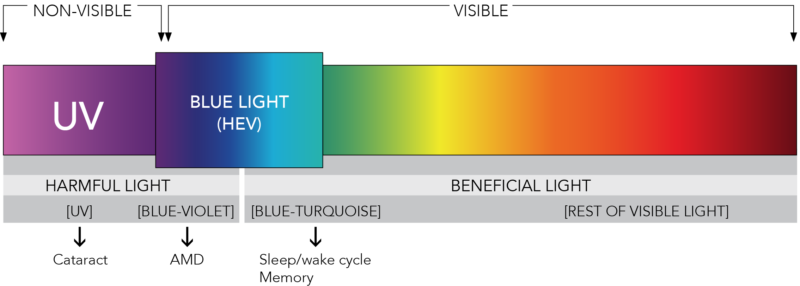Historically, the UV rays of the sun posed the most amount of danger to our eyes. As we’ve evolved into a society where we’re in front of screens more than outside in nature, there’s a new concern that’s emerged: the dangers of blue light.

Natural and artificial blue light
Blue light is on the spectrum of light visible to the human eye and is found everywhere there is light. In fact, these shorter, high energy blue wavelengths cause the sky to look blue when they collide with air molecules. Our bodies use blue light to regulate our circadian rhythm, or our sleep and wake cycles. When the sun is out and blue light is scattered, it can help us feel more alert, heighten reaction times and make us feel better.
But there’s been a surge of artificial blue light, emitted from our digital screens (TVs, computers, laptops, smartphones, tablets and fluorescent and LED lighting). This change may well harm our health and sleep.
The temptation to nestle with our phones in bed can disrupt our sleep cycle as blue light can disrupt your circadian rhythm by tricking your brain into believing that it’s daytime.
The risks of overexposure to blue light
Citizens of the digital age are often guilty of looking at their phones right before sleeping and right after waking. While looking at your device first thing in the morning may increase alertness, the temptation to nestle with our phones in bed can disrupt our sleep cycle as blue light can disrupt your circadian rhythm by tricking your brain into believing that it’s daytime. This is why Apple introduced the ‘night shift’ mode to iPhones in 2016, but their change in tone might not be enough as what we’re doing on our phones—scrolling, reading, getting notifications—can still keep our minds awake.

How to manage your blue light exposure
The most obvious solution to avoiding overexposure to artificial blue light: spend more time outside (cabin in the woods, anyone?) and put away your devices, especially before going to sleep.
We chatted with Ian from Pixel, a company that creates computer eyewear to protect your eyes from screens, on ways to manage the symptoms from starting at our laptops or phones for too long.
We’re already being impacted by blue light on a regular basis since we’re constantly glued to screens.
Ian emphasized the severity of this issue: “We’re already being impacted by blue light on a regular basis since we’re constantly glued to screens. People can experience digital eye strain after a short duration of staring at a screen.” Here are some tips from him on how to combat the eyestrain:
- Use the 20/20/20 rule, where you take a short break after 20 minutes in front of a screen.
- Reduce the brightness of your screen and keep a proper distance between you and the screen, about 16-30 inches
- Wear computer glasses to reduce eyestrain
To balance out our exposure to blue light, we’ve been testing out Pixel glasses at the Getaway offices:

While it may not be the best option for those who wear glasses already, it’s a great way for those with perfect eyesight to rock eyewear. That said, it still won’t beat the best way to avoid too much blue light disrupting your sleep cycle: to turn off your devices after work and to take some real time off.
P.S. Interested in winning your own pair? Enter our contest here.
